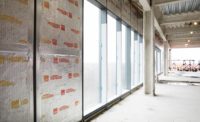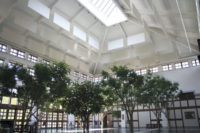Today’s high-performance buildings are designed to achieve a wide and often complex assortment of objectives, covering everything from aesthetics to energy efficiency, safety and resiliency, sustainability, circularity and more. A great deal of thought is given to how a building will look and function and also to how individuals will experience it. As such, building acoustics play an increasingly pivotal role as a design element central to occupant comfort and wellbeing.
Why Acoustics Matter
The reason acoustics matter is simple—sound affects everyone and deeply impacts their experience in a particular environment. It can have a significant impact on our productivity, our health, our ability to relax, to think, act, learn, feel or heal. Considering the acoustic needs of a building at the start of the planning process can help save time and money by reducing the need for renovations or retrofits once construction is completed. Increasing awareness and understanding of acoustics among industry professionals, including architects and designers, engineers, building owners, as well as the general population, will help drive the shift in sound strategy from afterthought to forethought.
Controlling Acoustics: Exterior Noise
What is noise pollution? Noise pollution, also known as environmental noise or sound pollution, is any sound that negatively impacts the health or quality of human or animal life. In the built environment, urbanization is largely responsible for the increase in noise pollution by bringing infrastructure and buildings—residential, commercial and industrial—closer together.
Buildings can be affected by multiple competing external noise sources. External noise pollution examples range from railways to streetcars, airports, busy roads, and highways. Yes, infrastructure is crucial to urban life, but the consequence is that it can be very noisy. The resulting vibration and traffic noise—not to mention human noise pollution—can all have a serious and negative impact, especially in densely populated areas.
The importance of noise pollution control should not be overlooked. Repeated exposure to noise may reduce sleeping hours, productivity and efficiency at work.
Regardless of the source, the goal is to keep outside noises out of our buildings. There are unique characteristics and challenges for exterior sound, and as a result, different strategies for how best to manage it. Managing exterior noise starts with understanding how it’s measured.
How is Environmental Noise Measured?
Just like all sound, exterior noise is typically measured in decibels. Because exterior sounds, especially in urban areas, often exceed 80 dB, they fall into the range of what is considered excessive or pollution. Creating a comfortable living space for building occupants means architects and designers need to take into consideration different methods to control sound. Outdoor-Indoor Transmission Class is one such method of understanding how the insulated assemblies reduce noise around the building.
The OITC rating was originally created to measure exterior walls, doors and windows. OITC also provides a number rating for roofs, facades and facade elements that are subjected to transportation and other exterior sources of noise. The higher the number, the better the assembly is at keep unwanted exterior sound out. When choosing building envelope designs, using the OITC rating as part of your criteria for material selection will provide more accurate results in particular when lower frequency noises are expected.
As a physical barrier between the conditioned indoor and unconditioned outdoor environment, the building envelope should be expected to maintain consistent levels of noise protection. Outdoor to indoor noise reduction is essential, especially when you’re looking for how to isolate or negate the road noise and other sources of noise pollution in cities.
Five of the most common sources or examples of noise pollution are transportation (airports, highways, railways, etc.), weather (hail, rain, wind, thunder, etc.), construction (heavy machinery, power tools), household activities (lawnmowers, leaf blowers, air conditioners, music, renovation projects), and heavy industry (industrial operations).
Controlling Acoustics: Code Overview
The International Green Construction Code
The IgCC offers specific guidelines for builders around controlling noise in different environments. Presently, the code is developed for high-performance applications but is slated for inclusion in the 2021 International Building Code update that will become mandatory. At that point, acoustics will become mainstream with statewide compliance throughout the U.S. Section 8.3.3.1 is titled Site Exterior Noise—focused on minimizing the effect of site exterior noise on building occupants. Under the code, wall and roof-ceiling assemblies must have an OITC rating of 40 or greater or an STC rating of 50 or greater, and fenestration that is part of the building must have an OITC or STC rating of 30 or greater for any of the following conditions:
- Buildings within 1,000 feet (300 meters) of expressways.
- Buildings within 5 miles (8 kilometers) of airports serving more than 10,000 commercial jets per year.
- Where yearly average day-night average sound levels at the property line exceed 65 dB.
ASHRAE and the International Energy Conservation Code
Under ASHRAE 90.1 and within the International Energy Conservation Code since 2015, there is a requirement to use continuous insulation. By using insulation across all structural members without thermal bridges, other than fasteners and service openings in exterior walls, your design can achieve improved energy efficiency. ASHRAE 90.1 has led to increased adoption of energy codes across the U.S. where architects are now specifying overall assembly performance to achieve prescriptive R-values.
While you should familiarize yourself with the code requirements for noise pollution for a new construction or renovation project, keep in mind that codes and regulations are considered the minimum standard. As the concerns around noise pollution have continued to increase, more stringent requirements have been developed to protect people who live in areas where it is a regular occurrence. Consider what you can do within your space to improve acoustic comfort such as reaching the LEED design requirements for exterior noise.
Controlling Acoustics: 3 Steps
There are three components to any plan for managing exterior sound: understanding the source-path-receiver model, selecting the right acoustic insulation for continuous exterior assemblies, and following general tips to soundproof from environmental noise pollution.
Step 1: Understanding the Source-Path-Receiver Model
When it comes to managing exterior sound, the source-path-receiver model continues to be useful. Looking at a commercial building, industrial facility, or even a residential home, the principle remains the same: start by looking at all the possible sources of noise and then look at all the possible entry points, or pathways, for the sound to travel. That list includes the roof, windows and doors, and wall assemblies.
Do you know which of these are the weakest sections of the building envelope when it comes to blocking external sound? You wouldn’t be alone if you assumed it was the exterior wall and roof systems. But you’d be wrong. Windows and doors are the most common culprit for allowing exterior sound to negatively affect the indoor environment.
That being said, building and design professionals are always encouraged to design exterior wall and roof insulation systems to help block as much of that environmental noise as possible. The overall mass of the wall and roof systems is what blocks most of the noise, but concrete alone isn’t usually sufficient, as it’s a poor medium for controlling other interior conditions, e.g. temperature. In addition, insulating exterior wall and roof systems means interior designers might even gain some freedom—needing fewer wall assemblies or other materials to block and absorb sound because the external noise is minimized by the building envelope.
Step 2: Selecting the Right Acoustic Insulation for Continuous Exterior Assemblies
Design practices from architects and builders are important in reducing noise and sound transmission. Pay close attention to material selection for insulation. When it comes to acoustic insulation, noise sources near the building will have a major effect on what type of building envelope material should be used. What is acoustic insulation? Acoustic insulation is one aspect of soundproofing your space; it is typically a component of a wall, roof or floor assembly designed to ensure sound comfort for occupants.
What’s the strategy behind noise control with insulation? You can improve the indoor acoustics and reduce auditory stressors by limiting structure and airborne transmission from external sources by integrating sound reduction measures into the basic planning and layout of your home or building.
Consider the following checklist when evaluating the insulation to use in your continuous insulation (aka CI) applications, which as outlined above, is now a required practice under most building code legislation.
- Raw materials used in manufacturing
- the insulation
- Manufacturing processes
- Operational performance
- Combustibility of the insulation
- Moisture mitigation properties
- Overall durability
- Impact on acoustic performance (OITC/STC)
While building codes and material costs should be a component of your selection process, the desired performance factors for your commercial office, healthcare facility, educational institution or other structure, are most important when evaluating and specifying products to deliver CI.
Stone wool insulation is well suited to deliver sound reduction benefits and control unwanted noise in occupied spaces. When properly installed in today’s building enclosures on the outside face of the building substrate behind the building facade, stone wool, as part of your CI system, supports thermal performance and provides additional acoustic comfort.
Block environmental noise pollution from neighbors, traffic, airplanes, construction sites and more by planning a good acoustics approach from the beginning with your choice of acoustic insulation.
Step 3: Tips for soundproofing from environmental noise pollution
To protect your building from environmental noise pollution, consider the acoustical performance of every assembly on the building envelope. Noise travels through the weakest sections of the building envelope, meaning the effectiveness of a high-performing wall or roof system may be reduced when the rest of the building is not equally designed.
In many cases, unwanted noise can enter the building under a door, through a window, your roof, or a connected exterior wall. This type of noise is called flanking noise. The assembly and its connecting features should be tested during the planning stage of a project to minimize flanking through the building envelope, especially the parts of the enclosure that are known deficits in a wall or roofing design (e.g. windows and doors).
Review and consider all of the following applications during the planning process of your next project:
- Roofing: Stone wool insulation has superior sound abatement properties, which is essential when designing today’s roof system. High-performing systems using stone wool insulation can add mass layers to assist with improving the sound attenuation properties of the assembly. Research has shown dense acoustic roof insulation, including stone wool flute fillers, are an effective solution to reducing sound transmission through a roof.
- Connecting assemblies: Areas of deficiency for façade sound transmission paths can be things such as roof soffits, vents, fans, air sealing details and probably many others depending on the type of façade system being constructed.
- Exterior wall systems: How can you reduce exterior noise coming in through walls? For starters, the addition of better acoustic performance in your exterior wall assemblies comes down to the type of construction and the building materials being used. All insulation for exterior walls should be designed to meet or exceed energy code. Choose materials that offer improved acoustic performance (such as stone wool) while still meeting the other demands of your assembly to create cost-effective solutions and more livable spaces. For example, foam plastic insulation with multiple layers of gypsum could be optimized with stone wool insulation and a single layer of gypsum.
- Windows and doors: Windows are one of the largest deficits in building wall design for acoustical control and heat loss. Pay careful attention when designing the windows and their connections to the wall elements for a high-performance wall system. Consider the type of window (we recommend double- or triple-pane for best acoustic performance), the pane thickness and how it will be installed.
The higher the likelihood of exterior noise (i.e. traffic noise or aircraft) the more assemblies including the roof-ceiling and exterior walls should be focused on sound isolation. All exterior penetrations and joints between components should be sealed as required for thermal performance which will also improve the building acoustics.
The common thread throughout these tips for soundproofing from environmental noise pollution is using stone wool which provides a high-density acoustic insulation solution. This makes the insulation resistant to airflow and excellent at noise reduction. See the graphics for an overview of three assemblies focused on the exterior walls and roof systems of the building and demonstrating which combination of construction and materials provide the highest levels of STC, OITC and R-value.
With indoor environmental quality top of mind, the goal for the acoustic plan of a building should be to design comfortable and productive spaces that reduce the impact of external noise pollution. Architects and designers can gain some design freedom by looking at the building, and the acoustics plan, holistically.
Much of a building’s sound blocking can be achieved by the building envelope—essentially stopping noise from coming in from the exterior to minimize the amount you need to do on the interior. For example: develop quiet spaces away from outside noise sources to create distance between the receiver and the noise source.
Insulation is one of the basic and most practical ways to reduce noise pollution in homes and non-residential buildings. Common noise barriers and exterior flanking paths should be considered when marrying acoustics strategies with design.
Summary
Noise pollution is a growing concern, and while exterior environmental noise is a reality, there is a solution. Building design and construction professionals need to consider environmental noise pollution along with all other acoustical needs early in the project planning process, whether it’s new construction or a renovation/retrofit.
Increasingly, governments are recognizing the negative impact that external noise can have and are creating regulations to limit its impact. Those regulations are a good starting point but there is much more that can be done. By considering the various sources of noise, as well as the potential paths for sound to travel into a building, and then selecting the right design, construction assemblies and materials to mitigate that noise, spaces with high acoustic comfort can become the norm.
Ultimately, the unique acoustical needs of each space should guide the plan but as these recommended considerations are slowly becoming standard practice in building design, external noise control will help improve the experience for building occupants.
For more resources, visit rockwool.com. Next time, the topic is Controlling Acoustics: Interiors—minimizing interior noise to achieve sound isolation (sound blocking).
What Is the Difference Between OITC and STC?
Outdoor-Indoor Transmission Class (OITC)
Used for measuring external noise transmission into the interior. Originally developed for roofing, exterior walls, and elements such as windows and doors. Today, it is the best sound rating system to use for these potential sound entry points. Measures sound transmission loss from 80 to 4,000 Hz.
Sound Transmission Class (STC)
Sound transmission rating for interior building partitions subject to various noises one could experience in high-rise buildings, including between units, between corridors or around mechanical service spaces. Best sound rating system for measuring common sounds, such as speech. Measures sound transmission from mid to high-frequency noise sources, and Measures sound transmission loss from 125 to 4000 Hz.










Report Abusive Comment